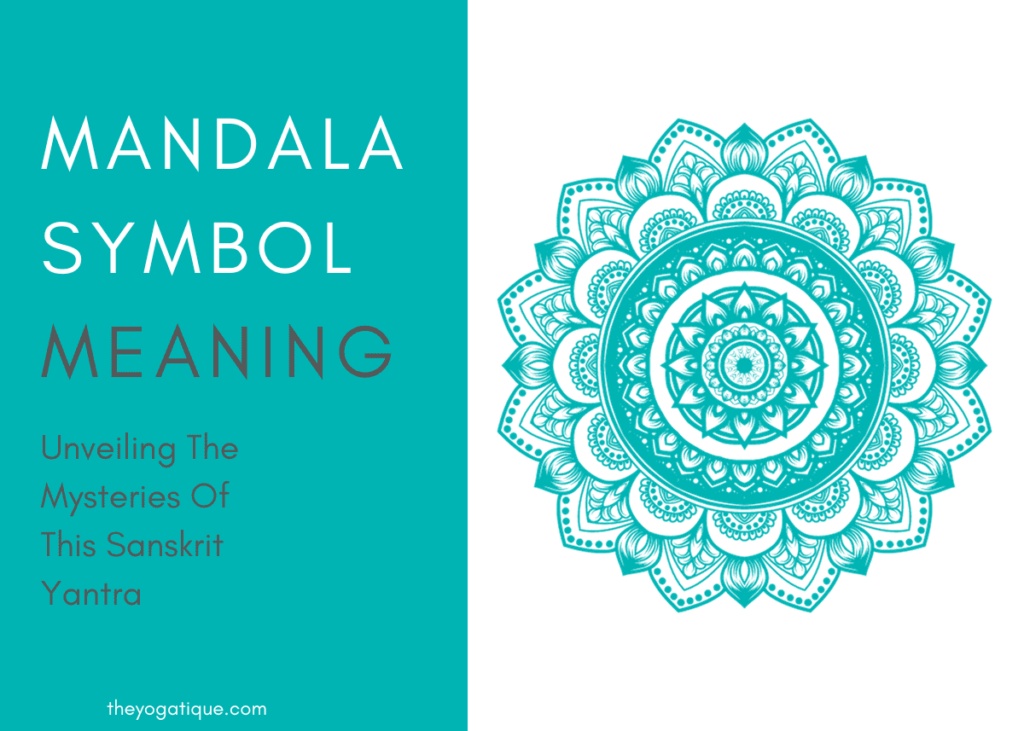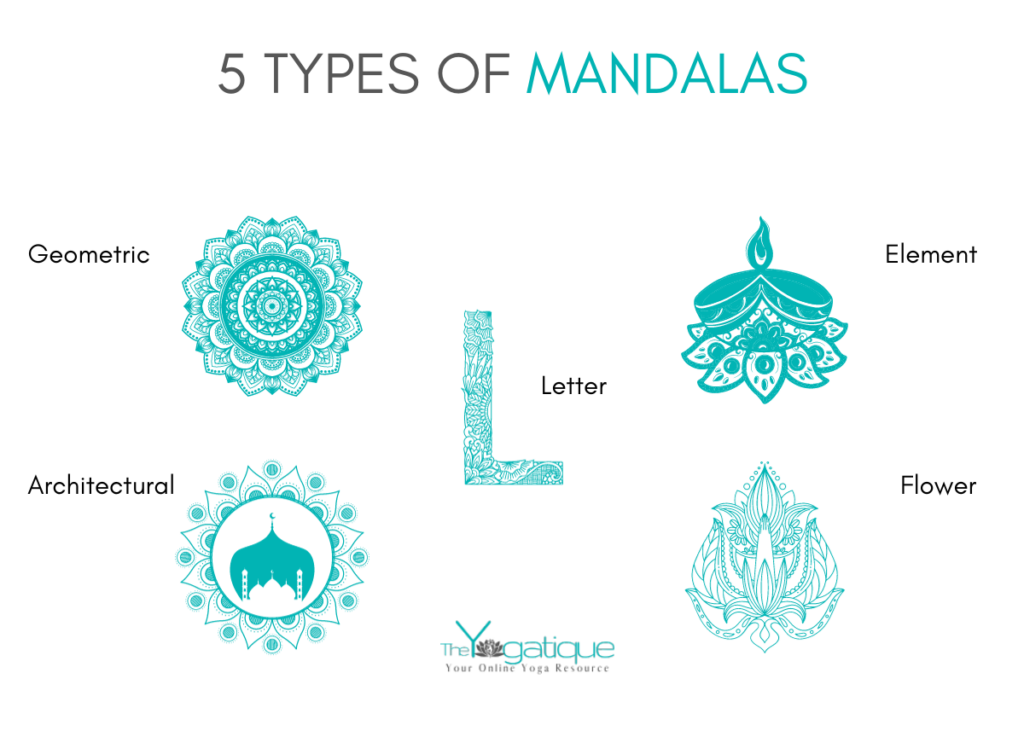
Whenever I see a mandala, I'm mesmerized. And learning about the mandala symbol meaning has only deepened my fascination with this ancient yantra.
I remember the first time I set eyes on a mandala. It was a large mandala painting on an altar at the front of a yoga studio.
As the yoga teacher instructed us to close our eyes and connect within, I couldn't help but keep my gaze fixed on this geometric symbol's vibrant colors and comprehensive patterns.
Now, whenever I find myself stressed, anxious, or overthinking, I sit and draw or color a mandala, and instantly feel a sense of calm wash over me.
If you're looking for a stress-relieving, mindful activity, this article is for you. I'm sharing all about the mandala symbolism and origins, as well as detailed instructions on how to meditate with one and create your own!
Article content:
(Click any link below to jump directly to section)
Mandala origin
The term “mandala” comes from the ancient Indian language of Sanskrit, where it means “circle.” The first documented image of a mandala was in the Hindu text, the Rig Veda, written around 1500 BCE. So, it is believed that the mandala's true origins were in India.
Still, since then, mandala symbols have appeared worldwide, such as:
- In Persian art as the Ishtar Star Symbol
- In figures in Mesoamerican architecture
- In Native American art, such as the Aztec Sun Stone
The use of mandalas dates back to the early centuries. They have such a long and vast history, so their origins are not exclusively tied to a single culture. Instead, they emerged independently in different parts of the world over time.
The history of the mandala symbol
Mandalas became popular in Buddhist practices when Buddhist monks transported doctrines and artifacts from India in the 3rd century BCE. As Buddhism spread throughout Asia, so did the mandala symbol, appearing in Tibet, China, and Japan during the 4th century.
Along with painting and teaching mandalas, Buddhist monks began creating them using sand as part of their meditative rituals, known as a sand mandala.
Meanwhile, various Native American tribes and indigenous cultures created and used their own circular and symmetrical designs in their artwork and rituals.
Ancient European cultures, including Celtic and Norse civilizations, also used circular and spiral motifs in their art and symbolism, representing the cycles of life, nature, and the cosmos.
Moving closer to the modern day, creating and coloring mandalas have been a widespread spiritual, therapeutic, and artistic practice during the 20th and 21st centuries.
Nowadays, mandala coloring books serve as a form of meditation and relaxation, while mandala jewelry and home decor are becoming increasingly popular.
What does a mandala symbol represent?
Healing mandalas have many representations, the most common being unity and oneness. You can see this symbolism in its symmetrical design, which radiates from a central point with all lines connecting. This links to the idea that everything is connected in the universe.
In some cultures like Tibetan Buddhism, mandalas represent the universe, encapsulating cosmic energies, celestial bodies, and the cycles of nature.
Other interpretations of the mandala symbol are:
- Balance, harmony, and equilibrium – Drawing or meditating with a mandala can help to bring order and calmness to your thoughts and emotions.
- Spiritual Journey – Mandalas can represent a path to self-discovery, enlightenment, and self-realization. As you move from the outer circles toward the center, you move closer to your true self, gaining a deeper understanding of reality.
Mandalas spiritual meaning
Mandalas serve as a spiritual symbol in many Buddhist traditions. Meditating on a Buddhist mandala is believed to lead to insight, spiritual awakening, and a deeper understanding of the nature of reality.
Here are two other ways mandalas are used in the Buddhist community:
- Sand mandalas – In Tibetan Buddhism, sand mandalas are created as ritual art using colored sand, grains, or other materials. These Buddhist mandalas are then ritually dismantled and offered as gifts to deities or enlightened beings during ceremonies to symbolize the impermanence of all things.
- Initiation and Empowerment – In certain Tibetan Buddhist schools, mandalas are used to initiate individuals into specific practices or empower them with spiritual energy. The practitioner receives blessings and teachings through the visualization and interaction with the mandala.
Mandalas in Hinduism
In Hinduism, mandalas are present in various practices, art, and rituals. They are known as Yantras and are used for meditation, worship, and as tools to invoke particular energies or deities.
These are three ways mandalas are used in Hinduism:
- As religious art and architecture – Mandalas are often incorporated into Hindu temple architecture and religious artwork, typically as central motifs in the ceilings, floors, and walls. These mandalas symbolize the universe and the divine order.
- In rituals and offerings – Mandalas can be created as offerings during religious ceremonies. They may be made from colored powders, grains, flowers, or other materials and placed on altars as an act of devotion to deities or cosmic forces.
- To represent deities – Some mandalas in Hinduism represent specific deities and their attributes. These mandalas showcase the deity's various aspects and powers and are used in devotional practices to connect with the divine.
5 types of mandalas

Did you know there are many different types of mandalas?
While they all share the same mandala symbolism, they have differing design elements and patterns.
5 common mandalas you may come across are
- Geometric mandala – This is the most common type of mandala, featuring symmetrical patterns of lines and geometric shapes. They can be any shape, such as a circle, semi-circle, triangle, or square, but what they all have in common is a clearly visible center from what the patterns radiate out from.
- Flower mandala – This is another typical mandala, especially for drawing and coloring. The main pattern found in this mandala is petals, though they usually consist of a combination of petals and circles/semi-circles. The flower mandala symbol meaning is rebirth, empathy, and self-love.
- Architectural mandalas – These elaborate mandalas have the most depth and number of layers. They are often found in sculptures, but they can also be 3D drawings. Many of these are teaching mandalas, where each shape, line, and color carries a unique philosophical representation.
- Element mandala – Element mandalas feature element symbols, deity figures, or depictions of the universe within their design. They are typically a square shape with inner circles. One of the most common is the Mandala of the Five Elements, which was used in Ayurvedic medicine to explain the relationship between diseases and their treatments.
- Letter mandala – Like its name suggests this unique mandala style is shaped like a letter, containing pretty patterns. They are popular in mandala art and often found in home decor.
2 popular ways to use a mandala symbol
The two most common ways to use healing mandalas today are in meditative practices and as art.
As mentioned, there are many spiritual and ritual uses of this sacred symbol. But besides their traditional use in Buddhist and Hindu cultures, how are they most commonly used in Western cultures today?
Let's look at how to use a mandala in both of these ways.
1. Meditation mandalas
To use a mandala in meditation practices, you will first need to find an image of one that you resonate with. I recommend drawing your own (as detailed below), but you can also use a printed symbol or an object, such as a mandala necklace.
Once you have your mandala, find a quiet and comfortable place and follow these instructions:
- Get comfortable – Ensure you're sitting with a straight spine. You might like to elevate your hips with a cushion or pillow if sitting on the floor.
- Set up your mandala – Position your mandala at eye level in a spot where you can comfortably gaze at it without strain. Placing it on a meditation ritual altar is ideal.
- Connect to your breath – Close your eyes and breathe in for a count of four, then exhale fully for a count of six. Repeat this for a few minutes or until your mind starts to settle.
- Fix your gaze – Open your eyes and set a soft gaze on the mandala's center. Observe the shapes, lines, and patterns without analyzing or interpreting the design.
- Balance your focus between the mandala and your breath – Breathe naturally, feeling the inhale and exhale without trying to control it. If your mind wanders, use the mandala as your anchor to the present moment by redirecting your focus to the design.
- Explore the Details – After a few minutes of gazing at the center, slowly explore the details on the outer sections of the mandala. Observe all the different patterns and shapes.
- Move your focus back to the center – After a few minutes, gradually move your attention from the outer layers back to the center. As you do this, imagine you are journeying inward, toward the heart of the mandala.
- Take a moment to reflect – Before you finish the meditation, allow any thoughts, insights, or feelings to arise. If nothing comes up, this is okay; just be open to receiving any messages from the universe.
- Close the meditation – When you feel ready, slowly redirect your gaze away from the mandala. I find it helps to close my eyes for a few moments, then reopen them and slowly look around the room. This helps to bring your awareness back to your surroundings.
2. Mandala art therapy
Mandalas are a fantastic way to tap into your creativity while deepening your spiritual awareness. And the good news is that you don't have to be a skilled artist to give it a go.
Trust me, I thought I was not skilled enough to draw mandalas until my friend showed me how, and I realized it was not as difficult as I imagined.
Here is a step-by-step process for creating your own mandala artwork:
- Draw the center point – First, lightly mark the center of your paper with a pencil. This is where the core of your mandala will start.
- Draw the outer circle – Next, use a compass or a round object to draw a large circle around the center point. This will be the outer boundary of your mandala.
- Divide the circle – Now, use a ruler or compass to draw lines and curves that divide the circle into equal sections, like a pie chart. You can decide on the number of sections, but 8 or 12 are most common.
- Start creating patterns – Starting with one section, draw a simple pattern, shape, or design element. Don't overthink it; just draw what first comes to your mind. It could be a petal, triangle, or half-circle. Drawing a mandala is about creative expression; there is no right or wrong way to do it.
- Repeat this pattern in each section – While you can create different variations in each section if you are new to mandala drawing, I recommend keeping it symmetrical by repeating the same design.
- Build layers – Once you have a pattern in each section, you can add more layers by adding more (and different) designs around the first ones.
- Experiment with shapes and lines – If you get stuck on what to draw, play with various shapes, lines, and curves. You can also experiment with dots and spirals. Allow your creativity to flow, and don't worry about perfection.
- Add details and fill the space – Keep adding details, filling up the space within each section. However, as mandalas are known for their symmetry, ensure you do not make each section look completely different.
- Finalize your design – Once you're happy with it, go over your pencil lines with a marker to make it stand out. Afterward, erase any leftover pencil marks.
- Add color – If you feel like it, you can add more creative expression by filling your mandala with vibrant colors.
- Reflect and Appreciate – The final and most crucial step is to take a moment to reflect on your creation and appreciate the energy you put into it.
Here is a great video tutorial of this process if you're a visual learner.
If you really feel you are not creative enough to draw a mandala from scratch, coloring a mandala can have the same calming effect. You can find many mandala adult coloring books that make a lovely stress-relieving and meditation practice.
Other ways to use a mandala symbol
Some other ways you can access the magic of a mandala are:
- For healing purposes – Mandalas represent the perfect harmony and balance we seek in the body, mind, and spirit. Because of this, mandalas are used in healing rituals to restore balance and well-being.
- For personal growth – Creating or interacting with mandalas is thought to purify the mind and transform negative emotions. In this sense, mandalas can be tools for self-discovery and self-improvement.
Takeaway on the mandala symbol meaning
Mandalas are not just beautiful and eye-catching pieces of art. They carry deep symbolization, representing unity, nature, and balance, facilitating your spiritual journey.
Considering the mandala symbol meaning, these geometrical patterns can promote a sense of calm and serenity. Whether you meditate with one, draw your own, or wear a mandala pendant, allow its magic to guide you toward choosing peace and unity in your daily life.
Some online yoga studios, online yoga teacher training programs, and brands that we write about may offer us a small percentage should you decide to purchase after reading our content. Thank you for enabling us to exist!






